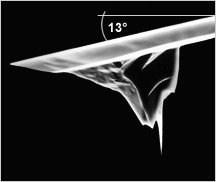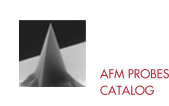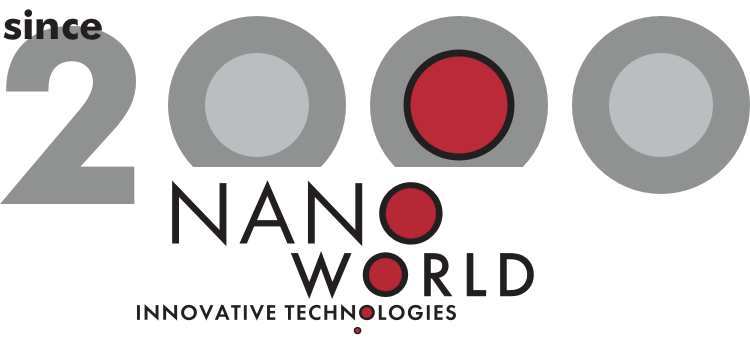Type: AR5T-NCHR
Tilt compensated High Aspect Ratio (> 5:1) - Non-contact/Tapping™ mode - High resonance frequency - Reflex coating

| Cantilever Data | Value | Range* |
|---|---|---|
| Resonance Frequency | 330 kHz | 250 - 390 kHz |
| Force Constant | 42 N/m | 21 - 78 N/m |
| Length | 125 µm | 120 - 130 µm |
| Mean Width | 30 µm | 25 - 35 µm |
| Thickness | 4 µm | 3.5 - 4.5 µm |
*Typical values
This AFM probe has alignment grooves on the back side of the support chip.

Tilt compensated High Aspect Ratio Tip (AR5T)
NanoWorld® Pointprobe® NCH probes are designed for non-contact or tapping mode imaging. This AFM probe type combines high operation stability with outstanding sensitivity and fast scanning ability.
All SPM and AFM probes of the Pointprobe® series are made from monolithic silicon which is highly doped to dissipate static charge. They are chemically inert and offer a high mechanical Q-factor for high sensitivity. The AFM tip is shaped like a polygon based pyramid with a typical height of 10 - 15 µm.
These AFM probes offer unique features:
- Tilted 13° to the center axis of the AFM tip
- Length of the high aspect ratio portion of the AFM tip > 2 µm
- Typical aspect ratio of this portion in the order of 7:1
(when viewed from side as well as along AFM cantilever axis!) - Half cone angle of the high aspect ratio portion typically < 5°
- Typical AFM tip radius of curvature < 10 nm
 A trapezoidal cross section of the AFM cantilever and therefore 30% wider (e.g. NCH) AFM cantilever detector side result in easier and faster laser adjustment. Additionally, because there is simply more space to place and reflect the laser beam, a higher SUM signal is reached.
A trapezoidal cross section of the AFM cantilever and therefore 30% wider (e.g. NCH) AFM cantilever detector side result in easier and faster laser adjustment. Additionally, because there is simply more space to place and reflect the laser beam, a higher SUM signal is reached.
Tip shape: High-Aspect-Ratio
Aluminum Reflex Coating
The aluminum reflex coating consists of a 30 nm thick aluminum layer deposited on the detector side of the AFM cantilever which enhances the reflectance of the laser beam by a factor of 2.5. Furthermore it prevents light from interfering within the AFM cantilever.
| Order Code | Quantity | Data Sheet |
|---|---|---|
| AR5T-NCHR-10 | 10 | yes |
| AR5T-NCHR-20 | 20 | yes |
| AR5T-NCHR-50 | 50 | no |
| AR5T-NCHR-W | 380 | yes |
NanoWorld® Pointprobe® High Aspect Ratio AFM Tip (AR5 / AR5T) Screencast
Subscribe to NanoWorld® Youtube Channel
For more information contact: info@nanoworld.com
Pointprobe® is a registered trademark of NanoWorld AG
All data are subject to change without notice.
NanoWorld AG
Rue des Saars 10
CH-2000 Neuchâtel,
Switzerland
www.nanoworld.com
For detailed information about our AFM probe product series please see below:














 POINTPROBE®
POINTPROBE®
 ARROW™
ARROW™
 ULTRA-SHORT CANTILEVERS
ULTRA-SHORT CANTILEVERS
 PYREX-NITRIDE
PYREX-NITRIDE
 COATINGS
COATINGS
